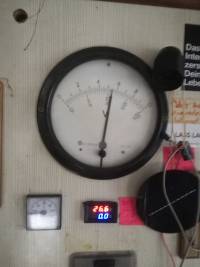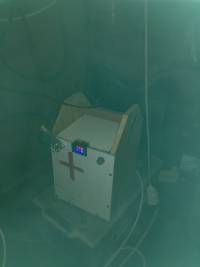Site Tools
Table of Contents
Electricity
7. Oct 2021
12 Volt System
At the moment the only one and running - light, fridge, water, gas, 240V. All projects running with 12 V with DC-DC converters. The devices in Moment: 2 Raspberry PIs for Grundl-TV and Sat-Uplink, WIFI-AP - Router and WSPR beacons.
Lifepo4 - batteries 4 pcs 176Ah in a wooden box ca 20cmx20cmheight ca 40cm
Chargeing Lifepo4 4S 4 in serie. LIFEPO4 Charging from 12.2Volt to 14.4Volt.
The charging current and consumer current can be read off the black charge controller by the battery.
The 12V solar panels are the small ones hanging horizontally on the south side and the solar ZILLE(SMALL SOLARBOAT OUTSIDE) which should always be connected, it is important it brings 300W.
The main fuse is on the battery. Further fuse in the lounge behind the grey circle.
24V System
Currently out of service - these are the 2 large 250W solar panels which also hang vertically.
WHY ARE THE PANELS HANGING DOWN: Because we need most of the energy in winter when the days are short and the sun does not rise higher than 15 degrees above the horizon and furthermore the snow does not stay on it. Please no more discussions why they are not on the roof. DOTO the 24 volt panels could also be connected to the 12 volt battery via the existing charge controller. the charge controller is an MPPT system which is nothing other than a DC-DC converter. This means that optimal battery voltage is always generated.
The 24V batteries are NIFE batteries, indestructible Edison batteries. They are in a red metal box of approx. 120cm x 80cm and a height of approx. 40 cm.
This BAtterien was last used for lighting only.
Solar charging before LAderegler and BAtterien
24V and 12V solar panels can be switched on/off manually by the system in the “Red Cross” box in the lounge. In this “Red Cross” box there is also a working car cigarette lighter with various charging cables. If possible, always charge everything via the 12V charging cable, which saves electricity.
220 Volt
There is a 24 V and a 12 V inverter for 240 volts. The 12-volt inverter can be switched on and off with a switch on the companionway. Switching the inverter off saves electricity.
GAS
Basically - GAS in the ship
Gas is heavier than air, it sinks down and fills the space. Unlike a camping bus or a caravan, however, there is no opening at the bottom of the ship where the gas can escape.
Therefore PLEASE BE CAREFUL.
The gas is therefore switched off 3 times.
- The mechanical thermal fuse directly at the gas flame
- The solenoid valve directly at the gas bottle. This only switches the gas on with 12V voltage. That's why there is no gas without electricity.
- On the control panel by the gas cooker there is a mechanical timer. This is the top switch (with the metal part). You turn the metal part slightly to the right and switch on this timer. When it has run down, it automatically switches off the voltage at the solenoid valve. This “egg timer” should NEVER be turned back - always let it run down - it will switch itself off. Maximum switch-on time is 90 minutes.
- In addition, the small black square switch at the very bottom of the control panel must also be switched on. (The switch that also has a yellow indicator light built in. This can be used to switch off the voltage to the solenoid valve even if the mechanical clock is still running down and should not be turned back.
Gas regulator on the gas cooker:
12 o'clock off
9 o'clock full power
6 o'clock(stop) minimum power.
Switch on the gas flame:
Press on a gas regulator and set to 6 o'clock. Use a lighter to light the flame. alternate between 9 o'clock and 6 o'clock with the regulator until the flame burns nicely on all sides of the nozzle.
The gas bottle is on the outside of the sundeck in the left-hand metal box, and there should always be a spare bottle inside.
Water
In the water circuit, the pressure is always kept at approx. 3 bar via a pressurised water pump. This pressurised water pump is located by the sink and can be switched on and off at the control panel near the gas cooker via the black switch near the gas cooker.
UP ON - DOWN OFF.
Turning off the water is important because:
- If there is a leak in a hose or pipe, the pump would constantly pump water into the vessel.
- The cistern of the toilet can leak and water would be pumped into the holding tank. This overflows and the shit runs into the ship or gets between the two hulls from there we would never get it out again.
Heating
The heating system is a gravity heating system. This means that when the kitchen cooker is heated, the hot water rises, cools down over the radiators and circulates back to the kitchen cooker.
daily operation
- When heating, monitor the temperature on the thermometer above the kitchen cooker.
- At 90 degrees water temperature becomes dangerous.
- At 100 degrees the water starts to boil and the pressure relief valve opens and boiling hot steam comes out.
- There must always be enough water in the circuit for the water to circulate.
Service
- Read the level on the transparent hose next to the voltage meter in the recreation room. Top up if necessary.
- Refill the antifreeze via the funnel and the green hose in the outside area - by the antenna cables. To do this, connect the green hose to the transparent hose and refill the antifreeze via the funnel.
- Simply refill water via the water pressure and the filling nozzle at the sink.
- The heating circuit is full when water runs out of the 12 volt solar panels outside. This is the case when the heating circuit is located 15 cm below the ceiling in the living room, and the expansion tank is also located at this height behind the grey circle.
Waste-holding Tank
The waste-holding tank is located directly under the toilet. The holding tank has a capacity of 750 litres.
Check the waste-holding tank from time to time to make sure it is full:
- manually by simply pressing on the cover.
- or by reading the level with a torch on a gauge right next to the 120mm inlet gauge.
TODO the holding tank has an overflow, but it is too small and always clogs. The overflow diameter should be increased. The overflow can be found in the rear bulkhead.
Hot water
Hot water collector outside
Hot water boiler behind the grey circle.
Shower.
Hose heating
 Except where otherwise noted, content on this wiki is licensed under the following license: CC Attribution-Noncommercial-Share Alike 4.0 International
Except where otherwise noted, content on this wiki is licensed under the following license: CC Attribution-Noncommercial-Share Alike 4.0 International
